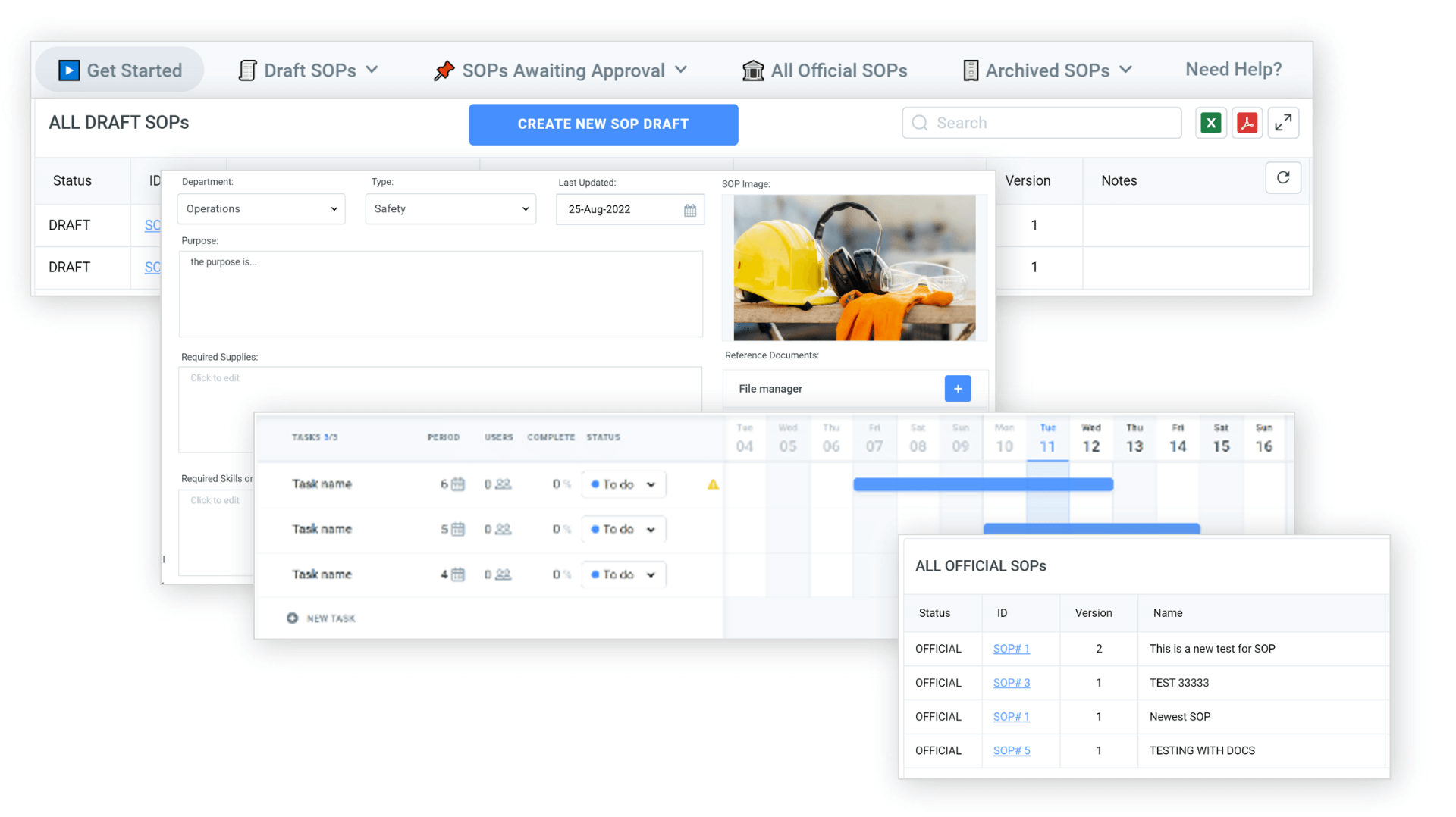You must have heard the saying, “Smooth seas don’t make skillful sailors.” Well, the business world isn’t a calm sea, either.
However, you can steer your ship to the shore with the right navigational tool, like an SOP manual.
SOPs ensure everyone knows their role, guiding your teams through the confusion and changing it into coordination.
According to a survey, 70% of organizations believe that SOPs play a critical role in maintaining compliance and consistent operations.
In this blog, we will discuss the purpose of SOPs, their need, components, and best practices. Let’s get started.
What is a Standard Operating Procedure?

A Standard Operating Procedure (SOP) is a documented set of instructions that outlines how to perform a specific task or process efficiently. SOPs ensure operational consistency, quality control, and compliance with regulations and industry standards.
By defining the steps and procedures required to complete a task, SOPs eliminate guesswork and reduce variability in operations. SOPs also serve as essential training manuals and resources, providing new employees with clear guidelines and instructions to learn and understand the organization’s operational processes quickly.
SOPs also play a significant role in maintaining quality and meeting regulatory requirements. They detail the steps, regulations, and quality control measures necessary to produce products or deliver services that meet industry standards.
How to Create an Effective Standard Operating Procedure
Learning how to create an SOP helps to streamline operations, improve efficiency, and ensure consistency within an organization. Here are the steps to create one:
1. Spend Time on Research
Countless processes run an organization. Does that mean every process should be documented? Not necessarily!
You can identify the critical processes and tasks employees regularly perform and create SOPs to make their work easier. Conduct surveys asking employees about the methods and tasks they take up almost daily. Ask them about which processes are extremely important and need maximum accuracy.
Once you create the list of processes to be documented, consult with department heads for any changes or additions before moving forward with the writing process.
2. Set Your Goals
Creating SOPs is a laborious process that requires your employees’ time and effort, so get your goals right before taking the plunge. Besides, it would help if you also considered identifying employees’ pain points with specific tasks and processes so you have a clear picture of how exactly the SOPs will help.
Once you have this valuable information, setting goals for your SOP initiatives will be much easier. For example, the goals can be:
- Streamlining the customer support process
- Minimizing errors in a complex internal process
- Maximizing the productivity of specific teams
- Preventing hazardous incidents in the workplace
Getting your goals straight sets a clear path for your team, ensuring they are on the right track from the beginning.
3. Know Your Audience
Different SOPs have different audiences. Before beginning the writing process, you should have a crystal clear idea of your target end-users.
Keeping the key individuals, their specific needs, and pain points into account is crucial before you start crafting content. To learn about your target audience, ask yourself questions about:
- The size of the team
- The knowledge they hold about the process
- The roadblocks they face while performing the process
This information serves as the fodder for building SOPs that are relevant and helpful for your employees.
4. Build a Team of Document Creators
SOPs are built for employees, so it makes sense to have their complete involvement in the creation process by creating a team of document creators.
Identify employees with good knowledge of the topic and the bandwidth required to contribute meaningfully to your SOPs. Senior executives bring valuable insights, whereas subordinates can bring fresh ideas that spark innovation in the existing processes.
Identify the people who specialize in the subject and possess excellent writing and editing skills. Put them in charge of the writing process and let others focus on the administrative side. If a writer makes a mistake, the editor can help review the work, and the administrator can manage other activities.
5. Pick a Suitable Format for Your SOP
The next step is choosing an appropriate SOP format – step-by-step instructions, flowcharts, and checklists.
Remember that every format serves a different purpose. Understand the process you are going to document and the requirements of your target audience, and then choose the most suitable format.
For example, checklists can work great if a process is straightforward and doesn’t need much extra explanation. On the other hand, if a process is complicated and can be performed in multiple ways, leading to different outcomes, consider creating Flowcharts for it.
6. Start Documenting Your SOPs
Now that you know the basics of SOPs, it’s time to start writing them. As an SOP is a comprehensive document, it’s ideal to begin with an outline and then explore each topic in depth. An SOP’s outline must comprise of a:
- Home page
- The titles of all processes
- A table of contents
- The name of the department you are going to create the SOP for
- Signatures of all stakeholders
- The purpose of the SOP.
To simplify this lengthy process, adopt a standard operating procedure template with a predefined format. Such templates will reduce your work by half. They provide a ready-to-use structure, so all you have to focus on is creating amazing content for your Standard Operating Procedures.
7. Quality Check the Document
To keep the errors to a bare minimum or, even better, eliminate them all, you need to deploy a strict and transparent review system. Make it mandatory for everyone involved in the documentation process to thoroughly review and cross-check the content before rolling it out for your employees.
Once the writers in your team are done writing, the editors with more experience and knowledge of the process can take up the review work – one article at a time. Since they know the process inside-out, they will be able to identify gaps and inaccuracies and use their expertise to add more value to the written content.
8. Share SOPs with Your Employees
Employees should be able to access the procedures conveniently on their laptops, tablets, and mobile phones. You can even give employees the option to download the SOPs for future reference or use them in printed form—whatever they prefer.
Share SOPs on a centralized and safe platform, such as an internal knowledge base that employees can access 24×7, anytime, anywhere. This way, they can make the most of your company’s processes in their day-to-day work.
9. Revisit & Improve Your SOPs
With time, as your company grows and new processes are added, the SOP should reflect these changes to maintain its relevance. For that, you need to look for areas lacking meaningful content regularly and occasionally make the required updates.
As your employees start practicing the SOP, they will have both positive and negative experiences. Tap into these experiences, understand where your SOPs fall short, and make the necessary amendments to turn your SOP document into a highly relevant information hub.
Keeping a close eye on KPIs like article upvotes and downvotes, total searches, and poor-performing articles will help you maintain the quality of your SOPs.
What is the Purpose of an SOP Manual?
An SOP manual is a critical document for any organization, outlining clear and detailed instructions on consistently performing specific tasks.
Let’s have a look at the primary objectives of an SOP manual:
Enhanced Consistency
The primary objective of a Standard Operating Procedure manual is to enable consistency across the organization. By ensuring consistent performance of specific tasks, SOPs reduce variability and maintain quality and efficiency.
Every team member receives standard instructions and procedural guidelines specific to a task, so they are better equipped to perform actions as per company policies and strategies.
Improved Efficiency
An SOP manual helps increase organizational efficiency by identifying standard processes with clear instructions. Teams can follow these procedures instead of creating their own or wasting time figuring out the best way to complete a task.
Implementing operating procedures will also ensure that all steps are streamlined, minimizing duplication and maximizing effectiveness.
Better Quality Control
Standard Operating Procedures help improve quality control by ensuring products or services are produced or delivered frequently.
This improves the quality of products or services, reduces the chance of defects and errors, and enhances customer satisfaction.
Also, any issues can be quickly identified and corrected by referring to the SOP manual.
Refined Security
SOP manuals, in the form of user manuals for machinery help ensure safety by providing clear and concise safety instructions required for operational processes that involve machinery, equipment, or other hazards.
Such instructions prevent mistakes or accidents that could cause injuries to employees and lead to legal liabilities for the organization.
Guaranteeing Compliance
Businesses in highly regulated industries must comply with specific regulations and laws.
The SOP manual makes it easy for businesses to follow specific regulations by providing clear guidelines that ensure compliance.
Companies can also demonstrate to regulatory authorities how the business processes meet their particular regulation requirements.
What is the Need for an SOP Manual?
An SOP manual is a document that outlines the step-by-step procedures to perform specific tasks consistently in an organization.
SOPs help address several business challenges, let’s discuss those.
To Address Inconsistent Task Performance
Team members performing a task inconsistently can lead to confusion, misunderstandings, and mistakes.
Also, inconsistency in task performance can cause problems in quality control and customer satisfaction, increasing the likelihood of complaints, returns, and loss of business.
An SOP manual can prevent these issues by providing precise and concise instructions that ensure that employees perform tasks consistently in line with organizational policies and strategies.
To Deal With Reduced Efficiency
Without standard procedures, employees may waste time finding the best way to complete a task.
They may also create their own policies, leading to duplication of effort or sub-optimal task performance.
SOP manuals address these issues by providing clear guidance on completing tasks efficiently, minimizing delays, and conserving organizational resources.
To Mitigate the Risk of Errors
When employees do not have a standard procedure to follow, they may make mistakes, causing quality control issues.
These errors can cause safety hazards and result in financial losses. An SOP manual helps mitigate these risks by providing clear instructions that guide employees through tasks.
This increases the accuracy and consistency of task performance, reducing the chances of errors.
To Avoid Compliance Challenges
Specific regulations and laws must be followed for businesses that operate in regulated industries.
Compliance requirements can be tricky and vary based on industry, jurisdiction, and other factors. An SOP manual addresses compliance-related issues by providing clear guidelines that ensure compliance with relevant regulations.
To Address Safety Concerns
Some tasks, such as operating machinery or working at heights, may involve risks.
With proper procedures, employees could avoid getting into the risk of injuries. An SOP manual provides clear instructions on operating machinery safely, using personal protective equipment, and minimizing hazards, ensuring a safe working environment for employees.
To Reduce Employee Turnover
High employee turnover can be troublesome for businesses, leading to a loss of knowledge and experience.
An SOP manual can reduce this risk by documenting standard procedures and providing new employees with an accessible guide to the tasks they need to perform.
This can help maintain consistency and efficiency in task performance, even in high employee turnover.
FREE. All Features. FOREVER!
Try our Forever FREE account with all premium features!
What Are the Components of an SOP Manual?
A well-structured SOP manual consists of several essential components that provide employees with a thorough and organized resource. These components include:
Title and Table of Contents
An SOP manual starts with a clear and descriptive title and a table of contents.
The table of contents gives an overview of the manual’s sections, making it easier for users to navigate and locate specific procedures.
Introduction
The introduction of the manual sets its context and purpose.
It explains the significance of following standard procedures, outlines the benefits of consistency, and highlights the organization’s overall goals.
Scope and Objectives
This section details the scope of the SOP manual, specifying the tasks and processes covered.
It outlines the manual’s objectives and explains what it aims to achieve and how it aligns with the organization’s goals.
Roles and Responsibilities
The roles and responsibilities section details the key positions involved in each task or process.
It also explains the responsibilities of individuals or teams, ensuring that everyone understands their roles and who to consult for assistance or approval.
Procedures
The procedures section is the core of the SOP manual. It provides step-by-step instructions, usually in chronological order, for performing specific tasks or processes.
Each instruction is written clearly and concisely, using simple language that employees easily understand. It could also include visual aids like diagrams or photographs to enhance comprehension.
Forms and Templates
This section includes any relevant forms or templates that employees could need to complete during the execution of procedures.
These consist of checklists, log sheets, inspection forms, or incident reports. Providing these resources ensures consistency and compliance with documentation requirements.
References and Appendices
The references section consists of any external documents or references necessary for performing the procedures correctly.
This may include industry standards, regulations, safety guidelines, or other relevant documentation. Appendices can be added to provide additional details, explanations, or supporting materials that may be helpful to users.
Revision History and Approval
It is an essential element of an SOP manual as it helps to track any changes made to the SOP manual.
It documents the dates of revisions, who made the changes, and the approval process, ensuring that the manual is always up-to-date and authorized by the appropriate personnel.
SOP Manual Best Practices
Properly structuring and implementing an SOP manual enables organizational efficiency, enhanced employee understanding and consistency, and compliance with industry regulations.
Here are some SOP manual best practices:
Create a Core SOP Team
Set up a core team responsible for creating and implementing the SOP manual. This team should include experienced professionals who can accurately document procedures with precision and clarity.
The team should have representatives from each department that the SOP manual will cover and members who are subject matter experts on the processes being documented.
Invest in High-Quality Documentation
SOP documents should be understandable, comprehensive, and accurate. The language should be simple and conversational with minimum technical jargon.
Visual elements like diagrams, flowcharts, and photos can significantly enhance comprehension and should be included where necessary.
Ensure Clarity and Conciseness
SOP manuals should be clear and concise. They should cover step-by-step procedures arranged logically and consistently.
The procedures should be easy to navigate through a table of contents, and the language should be simple and consistent throughout the manual.
Identify the Measurable Criteria
Measurable criteria set the standards by which performance will be measured.
It is vital to set up clear performance metrics, including the tools and techniques for measuring those metrics, to ensure adherence to the defined procedures.
Train the Users and Implement Feedback Mechanisms
The success of the SOP manual lies in its proper implementation. So, providing extensive training to all employees who will use the SOP manual effectively is crucial.
A regular feedback mechanism should be established to ensure that the manual is up-to-date and relevant, allowing employees to suggest improvements, updates, and corrections where necessary.
Ensure Regular Maintenance and Review
Business processes change frequently, so SOP manuals require regular updates and maintenance to remain accurate and relevant.
Therefore, it is essential to set up a system to review and update SOP documents regularly. It helps to ensure adherence to the defined procedures and avoids confusion about the correct task approach.
Create Insightful SOP Manuals for More Efficient Business Operations
A Standard Operating Procedure (SOP) is essential for businesses to ensure consistency, efficiency, and compliance in their daily operations. SOPs help document step-by-step procedures, roles and responsibilities, and provide clear guidelines, which promotes clarity, reduces errors, and allows employees to perform tasks effectively.
ProProfs Knowledge Base is a robust sop software for creating detailed SOPs with its user-friendly interface and AI-powered, intuitive editor. You can leverage its collection of pre-built SOP templates to jumpstart the process. Multiple users can collaborate simultaneously on SOP documents with pre-defined roles and internal comments. The version control feature helps manage multiple versions of help sites, and the revision history enables you to track up to 30 recent changes to your knowledge base.
 Tips
Tips
We’d love to hear your tips & suggestions on this article!
FREE. All Features. FOREVER!
Try our Forever FREE account with all premium features!

 We'd love your feedback!
We'd love your feedback! Thanks for your feedback!
Thanks for your feedback!







